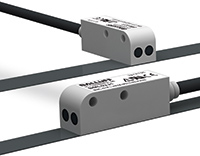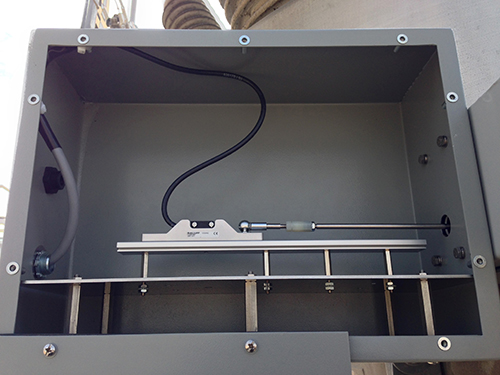Whether a linear system uses servo or stepper motors, adding a linear encoder can improve the performance of the machine and the quality of the process. In servo applications, the motor’s rotary encoder monitors its speed and direction, but a linear encoder monitors the load’s actual position. When stepper motors are used, position monitoring is especially important, as steppers typically run in open-loop configuration, making it difficult to verify that the system moved to the correct position.
The two most common types of linear encoders are optical and magnetic. Traditionally, optical scales were the sole option for resolutions below 5 microns. But improvements in magnetic scale technology now allow them to compete with optical scales at resolutions down to 1 micron. One such system is the BML series magnetic encoder from Balluff.

Image credit: Balluff Inc.
According to Tim Horgan, Industry & Key Account Manager—Electric Drives, for Balluff, the first consideration in choosing a linear encoder is whether the application requires incremental or absolute feedback. To make this determination, Horgan says users should consider whether they need to know the actuator’s position after a power loss. If so, an absolute encoder is necessary, since an incremental encoder will lose its reference when the power supply is interrupted, requiring a re-homing sequence to determine the load’s actual position.
Horgan points out that another way to decide whether an application requires an incremental or an absolute encoder is to consider whether re-homing is feasible after a power loss. Knowing the actuator’s exact position may not be critical, but if the travel distance is long relative to the machine’s speed, as is common with machine tools, an absolute encoder will help to avoid lost time and productivity due to lengthy re-homing sequences.
Whether incremental or absolute, the next factor to consider is what technology the application requires. As mentioned above, optical encoders, which use a light source and a photo-detector to determine position, are best for applications that require sub-micron resolution. But because their operation is based on detecting light, they are very sensitive to dirt and debris, which can disrupt the signal. For optical encoders, it is also important to maintain the proper gap between the sensor and the scale, to ensure the signal integrity is maintained. Shocks and vibrations can not only affect the sensor gap, but can also damage the sensor.
As their name implies, magnetic encoders use a magnetic reader head and a magnetic scale to determine position. Because they rely on a magnetic field rather than light detection, these encoders are mostly unaffected by dust, debris, or oil contamination. Shocks and vibrations are also less likely to influence magnetic encoders. They are affected, however, by magnetic chips, such as steel or iron, which may interfere with the magnetic field.

Image credit: Balluff Inc.
Regardless of the encoder type, maintaining the correct gap between the sensor and the scale is a key factor in a linear encoder’s performance, as it affects the accuracy of the measurement. Horgan points out that many manufacturers state encoder accuracy at the minimum gap, while Balluff states linear encoder accuracy at the maximum gap. This means that even if there is variability in the gap distance along the travel length, the user will always get the stated accuracy from the encoder, as long as the maximum gap is not exceeded. And in most cases, the accuracy achieved will be better than the stated value, as the gap fluctuates but remains below the maximum.
While encoders can add cost to a linear positioning system, their benefits often outweigh the additional expenditure. For example, when a linear encoder is used with a ball screw or ball screw driven actuator, often times a lower accuracy class screw can be chosen, since ball screw positioning errors can be compensated for by using the encoder feedback. But the real benefit of using a linear encoder is usually realized as an improvement in quality of the process or output—whether cutting, dispensing, or positioning. Laboratory automation is a perfect example. Many linear motion systems in laboratory equipment use stepper motors for lower cost, but need position feedback to avoid damage to the machine or loss of expensive test samples. For these applications, magnetic encoders can help ensure safety and quality of the process without driving up costs.


Leave a Reply
You must be logged in to post a comment.